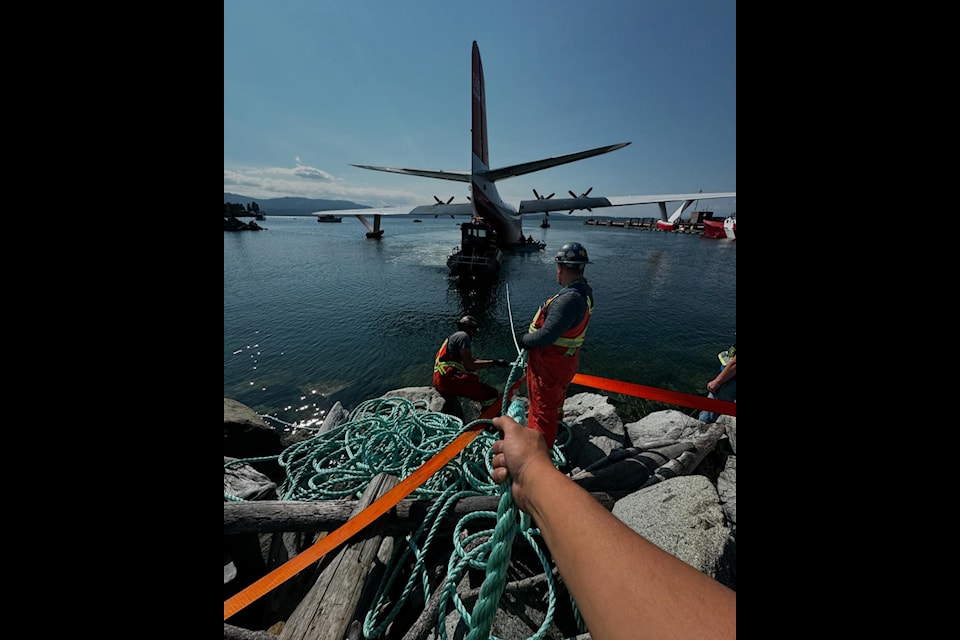In the dark of night, the bright red and white Martin Mars parked in a lot at the Canadian Coast Guard station in North Saanich will inch along to its new home outside the BC Aviation Museum.
With comments such as “out of this world” and “tears of joy” still resonating from the Aug. 11 historic final flight and landing, Richard Mosdell headed for the dock at Patricia Bay a couple days later to get the water bomber onto dry land.
“It's been a massive preparing operation,” Mosdell said of the next leg of the aircraft’s journey.
A Peninsula company happily hustled to make last-minute adjustments happen to get the iconic plane ashore.
“Yesterday was an amazing day,” said Mike Edwardson, owner of Villamar Construction. “When it’s crunch time and there’s so much at stake, that’s when you know what somebody’s made of. I’m just beaming today with so much pride in my team.”
A BC Aviation Museum member called on the local company after a last-minute flag that there needed to be a larger margin for error on the exit ramp from the waters of Patricia Bay.
“He didn’t get three words in and we were like, ‘Yes we’ll make it happen',” Edwardson said.
The ramp at the Institute of Ocean Sciences was too narrow by a few inches for the plane to fit when factoring in landing gear and room for cold water divers to navigate. A nearby dock piling was deemed in the way of the wing clearance, he explained.
Villamar had machinery and boots on the ground in 30 minutes under the capable leadership of site manager Drew Mackie, an aviation enthusiast and Save the Mars cheerleader who’d already visited it during its final days on Sproat Lake.
“We just believe when push comes to shove you have to show up. It was the hugest compliment BC Aviation would put their trust in us in such a pivotal moment," Edwardson said.
After finishing the alterations, the Villamar team joined Nickel Bros. in hand guiding the plane into shore to finish the dewatering, which includes a freshwater bath to remove salt water and corrosion.
Once planted in its massive reserved parking spot, Nickel Bros. – a company known for its large building moves across coastal B.C. – needed about five days to build a cradle for the massive aircraft.
The bomber will make a midnight move sometime during the week of Aug. 19 to 23, with specifics intentionally withheld for safety reasons, across the coast guard base, West Saanich Road and Victoria International Airport land to arrive at its new home at BC Aviation Museum.
Mosdell served as project lead on the Save the Mars campaign that officially landed the iconic and historic water bomber in the hands of the aviation museum on Norseman Road near the airport. Coulson Aviation announced the donation of its Second World War-era converted water bomber to the museum in spring 2023.
Hawaii Mars is one of two remaining Martin JRM-3 Mars water bombers. It flew cargo between Hawaii and the Pacific Islands during the Second World War and supported the Korean War with medical transport between Hawaii and California before transitioning to cargo operations. They were sold to a consortium of B.C. timber companies in 1958 and converted into the world’s largest water bombers to fight forest fires, carrying 27,000 litres per drop.
Coulson bought them in 2007, marking the start of its fixed-wing air tanker operations for aerial wildfire support. Coulson retired its Mars water bombers in 2015. The Philippine Mars is heading to the Pima Air and Space Museum in Tucson, Ariz.
The final Mars flight and landing in North Saanich was so popular the www.bcam.net website crashed, Mosdell noted, adding the live stream of the event continued growing at 2,000 to 5,000 an hour even two days later.
“The museum is doing a wide-ranging collection of stills and video interviews with everyone related,” Mosdell said. “That’s for our archives.”
Two separate crews are documenting the process – one for Coulson and one for the BC Aviation Museum archives – including the epic final flight in formation alongside the Canadian Forces Snowbirds.
Once Hawaii Mars is settled at the BC Aviation Museum as part of its existing B.C. Wildfire Aviation Exhibit, the goal is to build a new hangar dedicated to wildfire fighting. Find the online fundraiser at gofundme.com/f/save-the-hawaii-mars.
It starts as a closed display where visitors are welcome to walk around the outside of the aircraft while different crews complete the final open display preparations.
The museum hosts an official ribbon cutting, launching the “open” display format on Saturday, Sept. 28. At that time, guests may explore inside the aircraft and even sit in the pilot’s seat.



